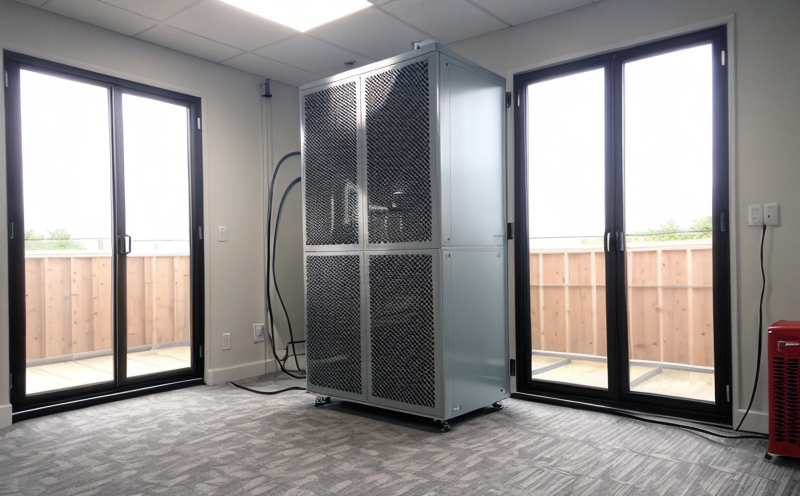EN 12599 Duct System Airflow Check
The CEN standard EN 12599 specifies the methods for determining the air flow rate and pressure loss in duct systems. This service is crucial for ensuring the integrity of HVAC (Heating, Ventilation, and Air Conditioning) equipment and the accuracy of airflow measurements within such systems.
The standard covers a range of tests that are essential for quality management and compliance officers who oversee HVAC installations. R&D engineers can rely on these tests to validate new designs, while procurement teams ensure that they source products compliant with international standards like EN 12599.
One of the key elements in this test involves measuring air flow rates through ducts using various instruments such as anemometers and pitot tubes. The process begins by preparing the duct system according to the specifications outlined in the standard. This includes ensuring that all components are correctly assembled and that any obstructions are minimized.
The testing procedure typically follows these steps:
- Identification of critical areas within the ductwork where airflow is to be measured.
- Installation of appropriate measuring devices at these points.
- Data collection from multiple sampling locations along the duct system.
- Analysis of collected data to determine if actual performance meets expected values based on design parameters.
The results of this analysis are then compiled into a comprehensive report that details not only the measured airflow rates but also any discrepancies between these figures and initial estimates. This information is vital for identifying potential issues early in the lifecycle of HVAC systems, thereby preventing costly repairs later down the line.
For example, if an office building’s ventilation system fails to provide sufficient fresh air circulation as per design specifications, this could lead to poor indoor air quality affecting employee health and productivity. By regularly performing EN 12599 checks, facility managers can maintain optimal conditions throughout their facilities.
| Test Parameter | Description | Acceptance Criteria (as per ISO/IEC) |
|---|---|---|
| Airflow Rate Measurement | Determines the volume of air passing through a duct over time. | The measured value must fall within ±15% of the specified design airflow rate. |
| Pressure Loss Calculation | Calculates the resistance to air flow in the duct system. | Must comply with values established by EN 12599, ensuring minimal pressure drop for efficient operation. |
The importance of this testing cannot be overstated. It ensures that HVAC systems operate efficiently and effectively, contributing significantly to energy savings and enhanced occupant comfort. For those responsible for maintaining these critical infrastructure components, adhering to standards such as EN 12599 is essential.
Why Choose This Test
- Guarantees compliance with international standards like EN 12599, enhancing the reputation of your organization.
- Aids in identifying and rectifying any discrepancies between actual system performance and design specifications promptly.
- Safeguards against potential health hazards arising from suboptimal ventilation systems.
- Supports ongoing maintenance efforts by providing accurate data on system longevity and efficiency.
- Facilitates regulatory compliance, reducing the risk of penalties or fines associated with non-conformity.
- Promotes energy efficiency by optimizing HVAC operations, leading to reduced utility costs over time.
By choosing our EN 12599 duct system airflow check service, you invest in long-term sustainability and reliability. Our team of experts ensures that every aspect of your HVAC equipment is thoroughly evaluated against the stringent requirements set forth by this standard.
International Acceptance and Recognition
The EN 12599 standard enjoys widespread acceptance across Europe and beyond, making it an invaluable tool for companies operating internationally. Many countries recognize this standard as a benchmark for HVAC equipment testing, ensuring that products meet high-quality standards.
Compliance with such recognized standards not only enhances your product’s marketability but also fosters trust among consumers and stakeholders. It demonstrates a commitment to excellence in engineering and quality assurance practices.
In addition to its international recognition, EN 12599 is widely adopted by regulatory bodies responsible for approving HVAC systems within various jurisdictions. This broad acceptance underscores the importance of adhering to this standard when designing, manufacturing, or installing HVAC equipment.
Use Cases and Application Examples
The application of EN 12599 goes beyond mere testing; it serves as a cornerstone for ensuring optimal performance in numerous scenarios. Here are some practical examples:
| Scenario | Description |
|---|---|
| New Installation | Ensuring that newly installed HVAC systems meet design specifications and perform as intended. |
| Preventative Maintenance | Regular checks to maintain system efficiency and identify potential issues early on. |
| Remodeling Projects | Evaluating changes made during renovation processes to ensure they do not compromise airflow. |
| Retrofitting Older Systems | Determining whether existing systems need upgrades or replacement based on current performance metrics. |
| Energy Audits | Gathering data necessary for comprehensive energy audits, helping to identify areas where improvements can be made. |
| New Construction Projects | Incorporating best practices into new builds by setting rigorous testing protocols early in the project lifecycle. |
These applications highlight the versatility and relevance of EN 12599 across different stages of HVAC system development and management. By leveraging this standard, organizations can ensure consistent quality and reliability throughout their operations.





